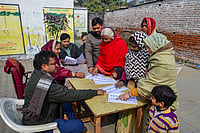Veteran location manager Kishor Sawant considers the search for a location to shoot the film the most fascinating part of filmmaking. Based in Mumbai, he knows the city inside-out and believes the city has a location for every story and plot.
A location can make or break the film, says Sawant.
With the advent of virtual production (VR), however, location managers like Sawant stare at uncertain times. The VR technology allows filmmakers to reproduce the desired locations indoors on large LED screens. From studios in Hyderabad, you can actually shoot scenes set in the American countryside with the rusty American landscape full of desert and cactus plants. While the technology has yet to become mainstream in India, it has already fuelled Hollywood hits like 'The Mandalorian' (2019), 'Avengers: Endgame' (2019), and 'The Fabelmans' (2022).
While the technology is set to empower independent filmmakers who may not always get actual locations of their choice because of budget constraints, there are also concerns that VR could upend the film industry as we have known it for decades. With that, there are also concerns that it could take away the livelihoods of millions who work 'behind the scenes' in lighting, set-designing, or location-hunting like Sawant.
The churn brought in by VR has also brought concerns about the films shot through the technology, with production designer and artist Aradhana Seth telling Outlook that the work at times may look "stilted". But, adds Seth, that would just improve with the time.
"Virtual production can sometimes produce stilted visuals — that might come across like a projection. With the advanced tech, however, even that is negligible," says Seth in an interview with Tanul Thakur and Ojas Kolvankar.
Seth admits that "entire professions run the risk of being redundant" and says distance is likely to creep in between the film and the filmmaker with the VR as being on the location allows a collaborative effort where you connect and reimagine the story and the location.
"Throughout my career, I've worked with people who were masters of carpentry and paint, who will now have to bear the brunt of the new tech's onslaught. Entire professions run the risk of being redundant. I'm also a huge fan of real-time camera movement and places. Going to a film set, absorbing the ambience, interacting with everyone (the director, the cinematographer, the costume people, and so on). It’s much more collaborative and exciting and fun. It lends the filmmakers to re-imagine, to communicate the story differently from what they had originally set out during the pre-production process, to think about the composition of the frame," says Seth.
For Sawant, the veteran location manager based in Mumbai, the "location must speak to you".
"We find romanticism in locations but getting a real-life location is tough. Sometimes the real-life location is so good that the writer is willing to make the changes," says Sawant.
With the advent of VR, how long can such romanticism continue? One does not know. Seth may have an answer. She says that virtual shoots will eventually take over the physical and the industry in the interim would need to upskill and catch up.
"The cinematographers, for example, need to understand how to work with it, as it produces better results with soft, diffused light as opposed to strong sunlight. So there'll be a point where virtual production and analog shoots will mix and then, as the tech gets better and more people become aware, the former will take over," says Seth.


























